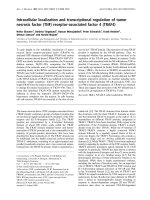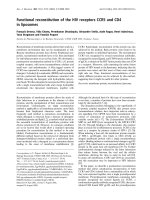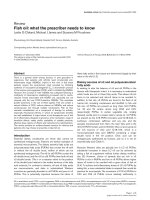Báo cáo y học: "Factor VII and the brain: time to get this research done" potx
Bạn đang xem bản rút gọn của tài liệu. Xem và tải ngay bản đầy đủ của tài liệu tại đây (35.29 KB, 2 trang )
Page 1 of 2
(page number not for citation purposes)
Available online />Abstract
Traumatic brain injury is the leading killer after trauma, in part
because of coagulopathy. Factor VIIa may be a useful therapy in
this setting, depending on the relative risk for thromboembolic
complications. Kluger and coworkers recently conducted a retro-
spective review of patients with traumatic brain injury from a
previous factor VIIa and trauma trial. It documents an encouragingly
low rate of complications, and should provide a strong incentive to
conduct a prospective study of factor VIIa in patients with severe
traumatic brain injury.
Kluger and colleagues [1] have done us a service with their
careful review of outcomes in patients with traumatic brain
injury (TBI) from a previous factor VIIa (FVIIa) trauma trial.
Although the numbers are small, this work will be important in
motivating future prospective trials. Mortality in this small
cohort was greater than in the overall study population,
emphasizing the lethality of TBI plus shock. The lack of self-
reported thromboembolic events is encouraging and is in
accordance with other prospective trials of FVIIa use, which
have suggested that the risk is real but not excessive. Also
encouraging are the trends in the outcome variables
reported, including mortality and organ failure end-points.
Although none of these are significant in themselves, they are
collectively significant in that they all vary in the same way,
favoring FVIIa.
Traumatic brain injury (TBI) is the most common cause of
death after trauma, and it is the most difficult to treat. With no
ability to repair or replace injured brain tissue, we are reduced
to management of symptoms as they develop and often futile
efforts to prevent secondary injury from hypoxia, hypotension,
hyperglycemia, hyperthermia, electrolyte imbalances, or
progressive cerebral edema. This task is especially complex
in the polytraumatized patient, because each associated
injury - whether treated or ignored - adds to the likelihood of
secondary TBI. Delayed fracture fixation increases the risk for
pulmonary dysfunction, whereas early operative repair
exposes the brain to the risks for hypotension, hypoxia, and
adverse effects of anesthetic agents. The combination of
hemorrhagic shock and severe TBI is especially lethal, with
mortality as much as 10 times greater than that for either
condition alone. Coagulopathy contributes a large part of this
pathophysiology.
Severe TBI causes coagulopathy through a number of
mechanical and inflammatory pathways, but the most
significant of these is simple consumption. The brain is rich in
tissue factor, which is exposed to the circulation in large
quantities when the blood-brain barrier is disrupted by
trauma. This leads to a coagulation defect through two
mechanisms. First, the already small quantity of FVIIa normally
found in the circulation is quickly consumed. Second, this
consumption triggers a strong local anticoagulant response,
which can easily become a systemic effect. Prolonged
prothrombin time is common following severe TBI, even
without evidence of systemic blood loss, and is a very strong
marker for poor outcome.
Recombinant FVIIa therapy for TBI has been enticing to
clinicians for the past 5 years. In our own series of patients
receiving FVIIa following trauma - perhaps the largest single
center experience in the world - TBI is the second leading
indication, found in about 150 out of 350 patients [2]. There
are several reasons for this anecdotal enthusiasm. The
immediate clinical effect is dramatic and readily observed; the
prothrombin time normalizes rapidly, even with small doses,
and surface bleeding from wounds visibly slows. Emergency
neurosurgical procedures are greatly facilitated, and
transfusion requirement is reduced. We have also harbored
the notion, unproven but physiologically sensible, that FVIIa
will slow the progression of TBI-associated intracranial
hemorrhage on both the macroscopic and microscopic
levels, and thus reduce the potential for secondary injury. To
Commentary
Factor VII and the brain: time to get this research done!
Richard P Dutton
University of Maryland School of Medicine, R Adams Cowley Shock Trauma Center, University of Maryland Medical System, MA, USA
Corresponding author: Richard P Dutton,
Published: 31 August 2007 Critical Care 2007, 11:161 (doi:10.1186/cc6097)
This article is online at />© 2007 BioMed Central Ltd
See related research by Kluger et al., />FVIIa = factor VIIa; TBI = traumatic brain injury.
Page 2 of 2
(page number not for citation purposes)
Critical Care Vol 11 No 4 Dutton
the extent that hemorrhagic stroke and TBI have similar
pathophysiology, early findings with use of FVIIa in stroke
patients have also been encouraging [3].
Tempering the use of FVIIa in TBI patients has been the cost,
the lack of clinical trials addressing this population, and -
most importantly - the unknown risk for thromboembolic
complications. After retrospectively examining this risk in our
own series of patients, we were struck by two things. First,
the baseline rate of post-traumatic cerebral infarction is not
well understood; retrospective diagnosis depends on the
presence of computed tomography scans with contrast
(unusual in TBI) or computed tomography scans obtained
days to weeks after injury (when infarcted brain can be
identified), and also to some degree on the resolution of the
scanner used. Second, the thromboembolic risk is closely
linked to the anatomic injury itself [4]. All of the post-FVIIa
brain infarcts observed in our series occurred in the presence
of severe TBI, just as the majority of all of the complications
we found occurred at the site of an identified vascular injury.
The current worldwide trial of FVIIa in trauma patients,
focused on the treatment of hemorrhagic shock, specifically
excludes patients with severe TBI. There is a clear and urgent
need to study this population, however, and to study the very
wide range of doses currently seeing anecdotal use, all the
way from 10 to 15 μg/kg in centers such as my own to the
400 μg/kg reported on by Kluger and coworkers [1]. Even a
modest improvement in long-term outcomes achieved by
early treatment with FVIIa would have an impact on the
population of patients with severe TBI and give us a badly
needed arrow for our therapeutic quiver.
Competing interests
RD has received research funding and consulting fees from
Novo Nordisk, Inc, the manufacturers of FVIIa and is a
member of their international steering committee for trauma
trials.
References
1. Kluger Y, Riou B, Rossaint R, Rizoli SB, Boffard KD, Choong PI,
Warren B, Tillinger M: Safety of rFVIIa in hemodynamically
unstable polytrauma patients with traumatic brain injury: post
hoc analysis of 30 patients from a prospective, randomized,
placebo-controlled, double-blind clinical trial. Crit Care 2007,
11:R85.
2. Dutton RP, Stein DM: The use of factor VIIa in haemorrhagic
shock and intracerebral bleeding. Injury 2006, 37:1172-1177.
3. Mayer SA, Brun NC, Begtrup K, Broderick J, Davis S, Diringer
MN, Skolnick BE, Steiner T; Recombinant Activated Factor VII
Intracerebral Hemorrhage Trial Investigators: Recombinant acti-
vated factor VII for acute intracerebral hemorrhage. N Engl J
Med 2005, 352:777-785.
4. Thomas GOR, Dutton RP, Hemlock B, Stein DM, Hyder M, Shere-
Wolfe R, Hess JR, Scalea TM: Thromboembolic complications
associated with FVIIa administration. J Trauma 2007, 62:564-
569.









